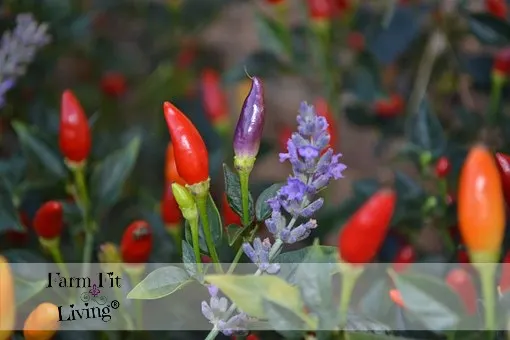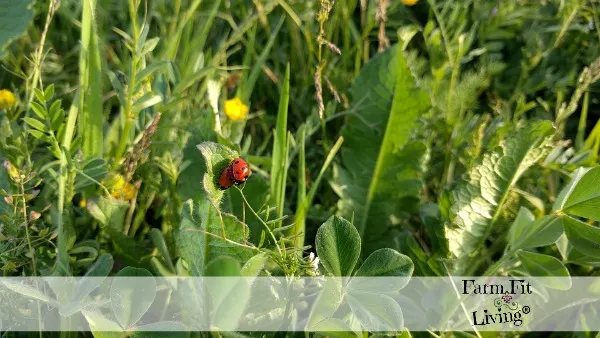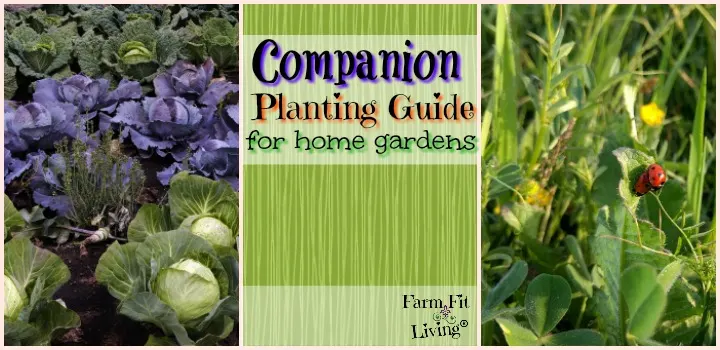Are you searching for a great companion planting guide to answer your questions about what plants to plant next to each other?
Well, you’ve come to the right page for a companion planting guide. You’ve found a very simple but in-depth source for companion planting.
You may have heard about what not to plant next to potatoes or other incompatible plants to seed into your garden. Not only can this information in the companion planting guide help you grow better vegetables, but it can also help you maximize space and efficiency use in your garden area. Add a companion planting garden lay out to your plan.
There are several benefits of companion planting for different reasons.
In this post, I’m going to:
- Introduce a companion planting guide for most vegetables, flowers and herbs.
- Give you some ideas of what plants to plant next to each other.
- Give you instant access to a great printable companion planting chart pdf you can use when planning out your garden.
Ok, so let’s jump right into the content. Why should you even be thinking about companion planting?
Why Companion Planting?
Plants are living, breathing organisms. And certain plants love growing next to other certain plants. They get along great and provide benefits to each other. Here are some benefits they can provide one another:
- Improve health or flavor of a companion.
- Interfere with growth of weeds or repel wildlife.
- Deter unwanted insects.
- Attract Beneficial insects for pollination.
These are just a few and I will go into further detail of the benefits in just a minute. You also must know that some plants don’t like other plants either…just like all living, breathing organisms. It’s called an antagonistic relationship.
- Plants with this relationship can be toxic to one another.
- They could steal nutrients or shade out the sun from the other.
So, it’s important to recognize this when you’re planning out your garden space. Now you know how companion planting and this companion planting guide can be very beneficial to how you grow your garden. Let’s go right into some examples of great companion partnerships between produce crops.
To read more about garden planning, go here.

Asparagus
An early crop, asparagus is typically done producing once the weather begins to heat up in late spring. Tomatoes have been shown to grow and produce very well next to asparagus after the harvest. Since their peak seasons are at different times, this relationship works well.
Herbs such as parsley and basil provide both vigor and flavor to the herbs and the asparagus.
Beans
Interplant beans into early crops, such as cole crops, carrots and beets. The herb summer savory has been known to improve growth and flavor, as well as repel bean beetles.
Avoid planting beans with onions or gladiolas flowers.
Beets
These root veggies thrive near bush beans, onions, kohlrabi, lettuce and cole crops. Avoid planting them next to pole beans.
Cabbage
Of course, cabbage loves being planted with other cole crops as well as brussels sprouts, collards and turnips. They also love herbs, such as dill, chamomile, sage and rosemary.
However, they do not like tomatoes, pole beans or strawberries.
Carrots
The carrot fly that harms carrots can be repelled naturally by planting next to onions, leeks, rosemary, wormwood and sage. Companion planting broccoli and carrots also works well.
Corn
Believe it or not, corn has many veggies as companions. They will grow well with potatoes, peas, beans, cucumbers, melons, pumpkins, and squashes. Fun fact: It’s the shade the corn provides that is loved by the melons, squash, pumpkins and cucumbers.
Cucumbers and Squash
Another reason why cucumbers are great with corn is that raccoons seem to not like cucumbers. So, this is an example of a natural pest repellent. Radishes are naturally repellent to cucumber beetle, so try planting some radishes in. Remember not to pull the radishes that are used for companion planting.
Cucumbers do not like potatoes or aromatic herbs.
Another note: Nasturtium repels squash bugs on both squash and cucumbers, so not a bad idea to plant it near these crops as well.
Lettuce
Such a peaceful, delicate veggie. Lettuce loves everyone and antagonizes no other veggie or herb. They especially do well with strawberries, cucumbers, carrots and radishes.
Onions
Beets, strawberries, tomatoes, lettuce, summer savory, chamomile and cabbages are all big fans of onions. However, peas and beans loathe onions and shouldn’t be planted together.
Quick tip: To help prevent onion maggots, scatter onion plants throughout your garden.
Pepper
I didn’t include the pepper in my printable companion planting chart. But, peppers love basil. I’ve also had great success growing peppers next to okra, tomatoes, and onions.
Tomato
One of the most famous veggies (or fruit?) on the planet is the tomato. What can be planted with tomatoes? It loves growing next to onions, carrots and peppers. Also herbs, such as chives, parsley, nasturtium and marigolds. Also, garlic planted between tomato plants has been known to protect them from red spider mites.
There has been some studies done on what type of marigold to plant that I will introduce to you in a minute.
Avoid planting cole crops, potatoes and fennel next to tomatoes.
So, I’ve given you a few guides in this companion planting guide on what and what not to plant next to each other. I haven’t covered every veggie but I do have more in my printable cheat sheet. It’s a companion planting chart for vegetables and herbs that you can print and take with you.
Get that printable cheat sheet instantly here

Do these Companion Plantings Really Work?
What if it doesn’t? There are some doubts about companion plantings. That they are old wives tales. That they only work together in certain areas in the world.
Here are some steps to test and know if these companion plantings work for you:
- Follow guidelines given about what to plant or what not to.
- Keep careful records of successes and failures.
- Learn the basic combinations and experiment.
Personal observation by you is important because no two gardens are alike. Stop the companions that are not working for you and keep doing the ones that do work.
I think you’ll find that the benefits of companion plantings outweigh the disadvantages in major ways. I told you that I’d go into more details of the benefits, so let’s do that now.
7 More Benefits of Companion Plantings
1. Improved Soil Fertility
I preach on the importance of building up the soil to improve your garden overall. This is the number 1 important and first things you should be doing each year with your garden. If you have to focus on one strategy, it should be soil fertility.
So, what can you do to improve your soil fertility? Well, first of all you can incorporate plants that fix atmospheric nitrogen in the soil. Legumes are great at doing this.
Legumes include: Beans, peas and clover. Their root nodules harbor Rhizobium bacteria that actually work to help fix nitrogen through a symbiotic relationship with plants. This helps benefit neighboring and rotating in of non nitrogen-fixing plants.
Rotate legume crops with non legume crops in your garden layout year to year.
Read more about soil fertility here.
Read about Organic Fertilizers here.
2. Trap Cropping
There are certain crops that protect another crop from a certain pest. I’ve listed a few above.
The trap crop can be from the same family or different family group, but the most important aspect is that it is more attractive to the pest. One more example is planting collard greens to draw the diamond back moth away from cabbage. Trap cropping (if it works) is a great natural way to keep your garden healthy and produce great produce.
Here are some more biological pest control methods you might be interested in.
3. Biological Pest Control
Allelopathy is when an organism produces one or more biochemicals that influence the growth, survival and reproduction of other organisms.
These chemicals are extracted from roots or aerial parts that can suppress or repel pests. In turn, this method can protect neighboring plants.
An example: The marigold releases thiopene which acts as a nematode repellent. If you have a nematode problem, this wouldn’t be a bad idea to try. And if you read a little bit more, I’ll tell you which marigold variety has been known to work best.
4. Beneficial Spacing Interactions
Where tall growing, sun-loving plants may share space with lower-growing, shade-tolerant species.
This type of companionship can result in higher total yields from the land. It can also yield pest control benefits because the taller plants can act as a trap crop for the other.
An example of this is planting sweet corn with beans or squash. The sweet corn deters the adult squash vine borer and protects the vines from the borer. Along with that, the vines are said to discourage coons from destroying the sweet corn and beans. In addition, the bean crop provides nitrogen for the plants! As you can see, this companionship would be a win-win.
5. Nurse Cropping
This is when companionship provides great benefits to one another, which is just another form of spatial interaction.
Tall plants may protect more vulnerable species through shading or providing a windbreak. You can also use nurse cropping by putting a shorter season crop next to a longer growing cycled crop. An example of this is broccoli and lettuce: As broccoli gets larger, it will shade the lettuce, thus, extend the lettuce season and prevent bolting.
6. Aesthetics & Beauty
My most favorite reason for companion planting. Promoting a beautiful healthy environment for my garden crops.
Companion planting combines beauty and purpose. It’s so fulfilling. It’s fun, appealing and you can use your imagination and try different companions for different problems you might be facing.
7. Security
It’s an insurance policy if you’re growing a garden to support your family. Whether you’re just growing for food or if you’re wanting to sell produce from your garden, Companion plantings can provide extra markets to pull from.
It also gives you security in case of a crop failure. New pests or diseases might come in that aren’t supported by the companions. Even if this happens, you still have your companions that should ultimately be doing well – At least well enough to make a yield.
So, what if something does go wrong? What if companions I try do not work. Well, let’s let some of the research do the talking. Here are some examples of some companion plantings that were researched and did not work.
Controlled Studies of Companion Plantings
The first study was done by the University of California in an effort to look at the effects of cabbage planted with catnip, nasturtium, marigold, summer savory and basil.
Here’s what they found:
- Cabbage/Catnip reduced cabbage worm eggs and larvae but had a good amount of worm injury. Also, average weight per cabbage head was reduced due to competition with catnip for sunlight, water and nutrients.
- The other Cabbage and Companion plantings did not show positive results – all were negative.
The second study is from the University of Georgia and studied companion plantings of:
- Beans/Marigolds
- Cucumber/Nasturtium
- Cabbage/Thyme
- Eggplant/Catnip
- Tomato/Marigold
- Tomato/Basil
What they found: While these companions still grow well together, none of these combinations prevented insect damage from major garden insect pests. You’ll have to find some other method of insect management.

Which Marigold to Use?
In a study conducted by Dutch researches, 800 varieties of marigolds were grown in hopes of finding answers to reducing hurtful nematode populations. Marigolds have been known to be attracted to marigold roots but are killed when they try to feed due to the release of ozone from the root.
The use of marigolds in cover cropping and companion planting must be live to control harmful nematodes. Also, the full benefit is only achieved when the entire area is covered with marigolds, so cover cropping is a more reliable method.
In the study, the French marigold has proven to be the most effective, while the Single Gold marigold provided almost 99 percent of the nematode control. Just something to think about if you use marigolds for companionship.
So, Will You Try Companion Planting?
You know the benefits and the companions. Now, you know the research. Will you still practice companion planting?
In this post, I’ve given you examples of the companions that grow great together as well as a cheat sheet you can take with you to remind you. You can use it when you’re planning out your garden space.
Also keep in mind plants that don’t like to be planted near each other. Common examples of this are: beans do not like onions or garlic, cabbage is not a companion of tomatoes, and potatoes do not do well with vine crops, tomatoes or sunflowers.
Finally, understand that your record keeping is important to help with the success of companion planting. And crop rotation, too. Mapping out your garden spots will help you to be more successful in knowing when and where your garden grows best.
What companions have you tried that you love? Please leave it in a comment below!
The Companion Planting Guide is a sample chapter in my book Smart Gardening Made Simple. You, too, can learn all the simple steps for becoming a smarter gardener.
~ Much Love ~


Companion Planting Cheat Sheet for You
What plant deters squash bugs or potato beetle? Instantly know what vegetables like each other or not to help you plan your garden layout more effectively. Enter your email below and this one-page printable companion planning cheat sheet will instantly appear in your email inbox.



Simple Straw Bale Gardening Tips You Can Use Anywhere
Sunday 17th of June 2018
[…] For a list of companion plants, go here. […]
11 Top Garden Challenges & Solutions to Overcome Them
Monday 9th of April 2018
[…] And for Companion Planting Tips, go here | Save it to Pinterest Here […]
Spring Berry Pie Recipe for Anytime of the Year | Farm Fit Living
Friday 30th of March 2018
[…] And Here about good Companion Plants for Strawberries […]
25 Planting Herbs that Attract Bees
Sunday 18th of March 2018
[…] For suggestions about other plants that grow great with basil, go here. […]
7 Hacks for Growing a Low-Maintenance Vegetable Garden
Sunday 25th of February 2018
[…] For more info on companion planting, go here. […]